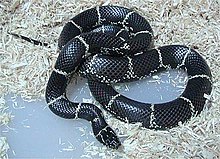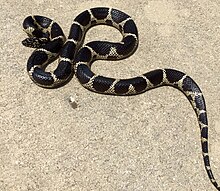
The milk snake or milksnake, is a species of kingsnake; 24 subspecies are currently recognized. Lampropeltis elapsoides, the scarlet kingsnake, was formerly classified as a 25th subspecies, but is now recognized as a distinct species. The subspecies have strikingly different appearances, and many of them have their own common names. Some authorities suggest that this species could be split into several separate species. They are not venomous to humans.

Kingsnakes are colubrid New World members of the genus Lampropeltis, which includes 26 species. Among these, about 45 subspecies are recognized. They are nonvenomous and ophiophagous in diet.

The California kingsnake is a nonvenomous colubrid snake endemic to the western United States and northern Mexico, and is found in a variety of habitats. Due to ease of care and a wide range of color variations, the California kingsnake is one of the most popular snakes in captivity.

The scarlet kingsnake or scarlet milk snake is a species of kingsnake found in the southeastern and eastern portions of the United States. Like all kingsnakes, they are nonvenomous. They are found in pine flatwoods, hydric hammocks, pine savannas, mesic pine-oak forests, prairies, cultivated fields, and a variety of suburban habitats; not unusually, people find scarlet kingsnakes in their swimming pools, especially during the spring. Until recently, and for much of the 20th century, scarlet kingsnakes were considered a subspecies of the milk snake; however, Pyron and Bubrink demonstrated the phylogenetic distinction of this species and its closer relationship to the mountain kingsnakes of the southwestern United States. These largely fossorial snakes are the smallest of all the species within the genus Lampropeltis, usually ranging from 40 to 50 cm at maturity. The maximum recorded length is in Jonesboro, AR 76.2 cm (30.0 in). Hatchlings range in size from 8 to 18 cm .

The desert kingsnake is a species of kingsnake native to Texas, Arizona, and New Mexico, United States. It is not venomous, colored yellow and black. The desert kingsnake's diet consists of rodents, lizards, and smaller snakes, including rattlesnakes. They normally grow 3–4 ft long, but have been known to grow up to 6.8 ft. They are docile creatures when confronted by humans. If they do not try to escape, often they "play dead" by flipping over onto their backs and lying motionless. Some who domesticate kingsnakes, such as ranchers, do so in the hopes that the kingsnakes will feed on other snakes, which might present more of a threat. It was previously considered a subspecies of the common kingsnake. The desert kingsnake belongs to the Colubridae family, which is the largest family of snakes in the world.
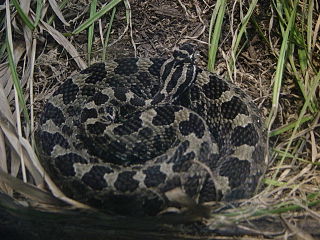
The eastern massasauga is a rattlesnake species found in central and eastern North America from southern Ontario in Canada and throughout the Midwestern and Eastern United States. Like all rattlesnakes, it is a pit viper and is venomous; it is the only species of venomous snake in Ontario.

The gray-banded kingsnake, sometimes referred to as the alterna or the Davis Mountain king snake, is a species of nonvenomous snake in the family Colubridae. The species is endemic to the southwestern United States and adjacent Mexico. Some sources list two distinct subspecies of Lampropeltis alterna, as L. a. alterna and L. a. blairi differentiated by patterning and locale, but research has shown them to be color morphs of the same species.

The speckled kingsnake is a species of nonvenomous kingsnake in the family Colubridae. The species is endemic to the United States.
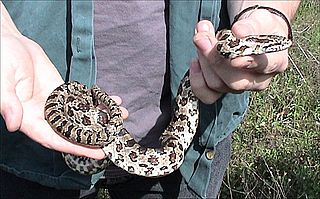
Lampropeltis calligaster is a species of kingsnake known commonly as the prairie kingsnake or yellow-bellied kingsnake.

Sistrurus miliarius barbouri is a venomous pit viper subspecies endemic to the southeastern United States.
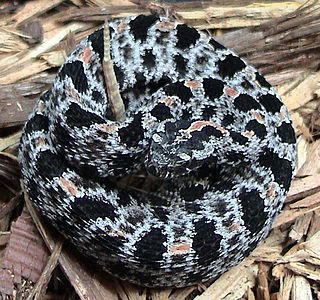
Sistrurus miliarius streckeri is a venomous pit viper subspecies found in the southcentral United States.

Nelson's milksnake is a subspecies of king snake that is found in Mexico from southern Guanajuato and central Jalisco to the Pacific Coast. It is also found on the narrow plains of northwestern Michoacán and on the Tres Marias Islands. The range of this snake appears to be tied to the proximity of watercourses, including ones utilized for irrigation and agriculture. It is a subspecies of the milksnake, Lampropeltis triangulum. It is similar in size to other king snakes, averaging 42 inches (110 cm) long, and like them, it is nonvenomous.
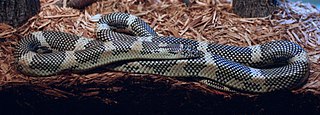
The Apalachicola kingsnake is a subspecies of nonvenomous colubrid snake found in a small area of the Florida Panhandle known as the Apalachicola Lowlands. Long argued as to whether or not it is a subspecies, the Apalachicola kingsnake was formerly named Lampropeltis getula goini. After years of research and many more specimens examined, in 2006, it was renamed to L. g. meansi after D. Bruce Means, in recognition of his work on this subspecies.

The short-tailed snake is a small harmless colubrid snake. Fossorial and seldom seen, it is found only in sandy, upland parts of Florida where it is listed as Threatened and is protected by state law.

Lampropeltis rhombomaculata, commonly known as the mole kingsnake or the brown kingsnake, is a species of snake in the family Colubridae. It is a relatively medium-sized snake that occupies a variety of habitats from Baltimore, Maryland, south through the Florida Panhandle and west into Mississippi and Tennessee.

Lampropeltis nigra, commonly known as the black kingsnake, is a species of nonvenomous colubrid snake indigenous to the United States. It is a species of kingsnake.
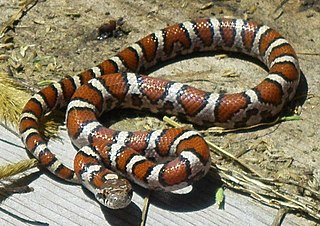
Lampropeltis triangulum triangulum, commonly known as the eastern milk snake or eastern milksnake, is a subspecies of the milk snake. The nonvenomous, colubrid snake is indigenous to eastern and central North America.

Lampropeltis mexicana, the Mexican kingsnake, is a colubrid snake that is endemic to Mexico.
